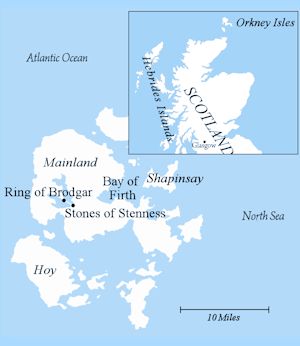The Mystery of Doggerland
Page 1 of 3
Around 3000 BC, the inhabitants of Great Britain and Ireland transformed rapidly into the Megalithic culture that erected hundreds of stone circles unique to the British Isles. Beside solitary stone circles, elaborate clusters of monuments were constructed, known as Megalithic complexes. They consisted of colossal stone circles surrounded by ringed ditches and embankments called henges, accompanied by massive artificial mounds, stone avenues, and free-standing monoliths. Such complexes were scattered throughout the countryside with smaller stone circles in between, often linked by alignments of individual standing stones covering many miles. As there are no written records from this era, writing not coming to the British Isles until the Roman invasion in the first century AD, the origins and beliefs of the Megalithic culture are shrouded in mystery.
Please click on cover image to order this book.
A Lost Civilization
In this new book, Graham Phillips examines the sensational discovery of what appears to be a previously unknown civilization on northern Doggerland, once an island off the northeast coast of Scotland that sank beneath the waves over 5,000 years ago. When the ice age ended around 10,000 BC, temperatures gradually climbed, and sea levels rose until approximately 5000 BC, after which the climate remained relatively stable for around 2,000 years before the seas again began to rise. Graham proposes that during this period of respite, an advanced society existed on this island centuries before the first civilizations of Egypt, India, and Mesopotamia, its survivors traveling to Britain when their homeland submerged to establish the Megalithic culture that eventually built Stonehenge. Exploring the latest archaeological findings and scientific analysis of recently discovered underwater remains in the North Sea, he reveals how this ancient culture had sophisticated technology, exceptional building techniques, and advanced medical knowledge years ahead of the time.
Left: The Megalithic culture was once thought to have started in southern England around 5000 years ago, but since the development of modern dating techniques, its oldest monuments are now known to have been constructed in the Orkney Isles to the north of Scotland.
The oldest Megalithic complex in the British Isles consists of monuments on the eastern side of the Loch of Stenness on Mainland Island, the largest of the Orkneys Isles. With monuments dating from as early as 3100 BC, it was centered on the Ring of Brodgar, one of the largest stone circles in the British Isles. At 340 feet in diameter, the ring is well over three times the size of Stonehenge. Originally consisting of 60 stones, of which 27 remain, standing up to 15 feet high, it is surrounded by a 400-foot-diameter circular ditch about 10 feet deep and 30 feet wide with an outer embankment, much of which has eroded due to its exposed setting. The ring is surrounded by other monoliths and an artificial hillock called Salt Knowe, a 130-foot-wide, 20-foot-high mound, and was initially linked by a mile-long avenue of standing stones leading to a second, smaller stone circle called the Stones of Stenness. Nearby is one of the remarkably well-preserved settlements where its builders lived: Skara Brae, a Neolithic village over 5,000 years old. Excavations here have revealed an early culture that mastered ingenious building techniques, erected huge stone and earthen monuments, crafted unique pottery, smelted soft metals such as gold, silver, and copper, and lived in sophisticated underground settlements 500 years before the ancient Egyptians built the pyramids of Giza.

Dating from about 3100 BC, the Stones of Stenness on Orkney’s Mainland Island is the oldest stone circle in the British Isles, which, together with the nearby Ring of Brodgar and other surrounding monuments, forms what is known as a Megalithic complex. Such arrangements of monuments were unique to the British Isles.

Skara Brae, a Neolithic settlement on the west coast of Mainland Island, is over 5000 years old. (Photography by Deborah Cartwright)
Perplexingly, it seems highly unlikely that the Megalithic culture originated on the Orkney Isles. Surprisingly advanced for the time, it appeared here abruptly – virtually overnight in archeological terms - with a complex societal structure, advanced mastery of building methods, sophisticated ceramics, and astonishing knowledge of herbal medicine already established, implying that it must have started and developed elsewhere. However, modern experts have long been baffled about where this might have happened. Nowhere in mainland Europe or Scandinavia was there anything remotely similar. So, where did the Megalithic culture originate?

It was once thought that this Megalithic culture began in the south of England, where Stonehenge is situated, before moving north, perhaps originating with migrants from northern France, where there are many ancient standing stones. However, there is no evidence of stone circles and their accompanying monuments remotely like those in the British Isles in France or elsewhere in continental Europe. However, since the advent of scientific dating techniques, it is now known that the oldest Megalithic stone circles are those in the northern British Isles, implying that the practice began there and then moved south. The revised conjecture was that it started around 5,000 years ago on the Orkney Isles, 10 miles off the north tip of Scotland, where the earliest Megalithic monuments are found.

The Mysterious Origins of the Megalithic Culture
Avebury in southern England is one of the many colossal stone and earthen complexes created by the Megalithic people of the British Isles in the third millennium BC.









